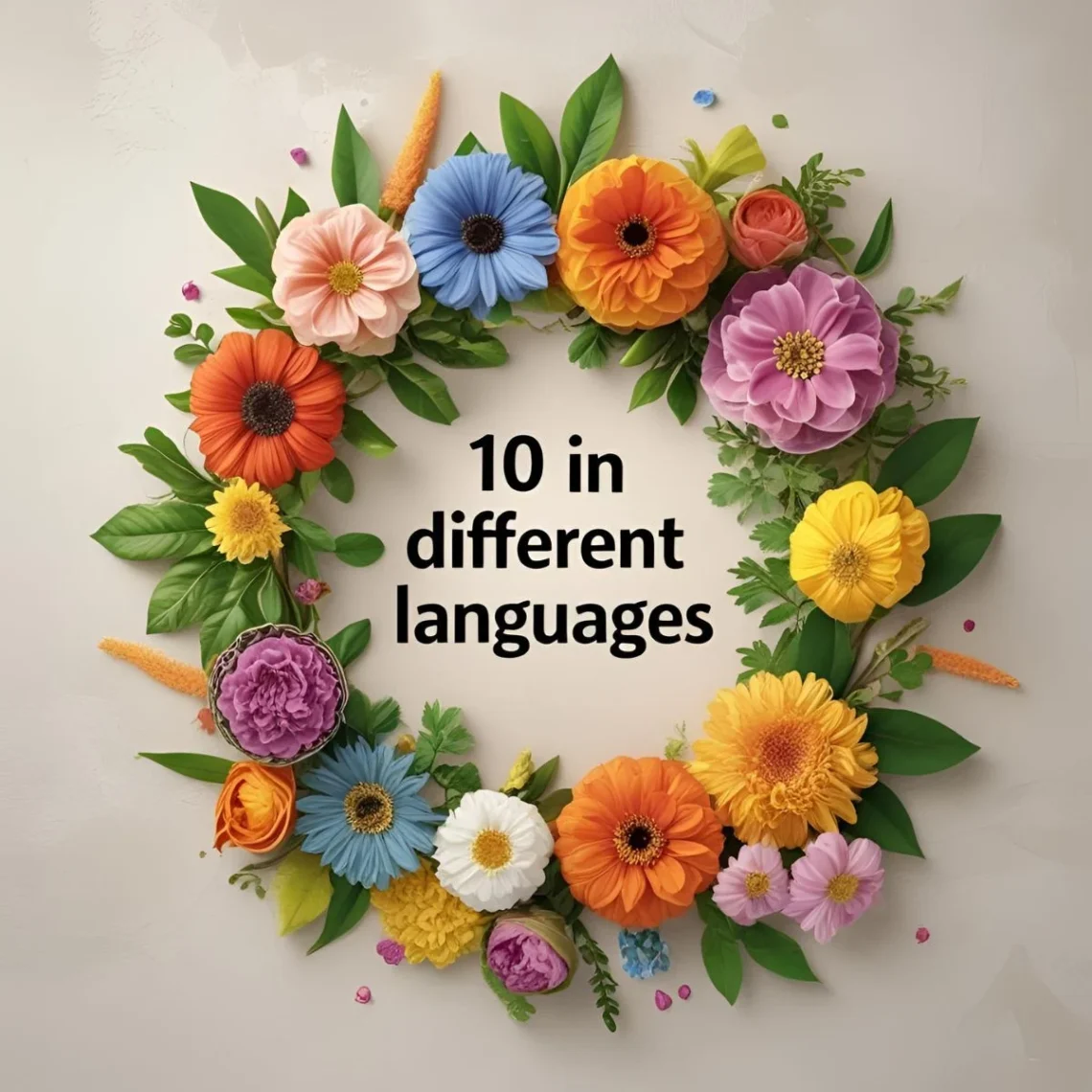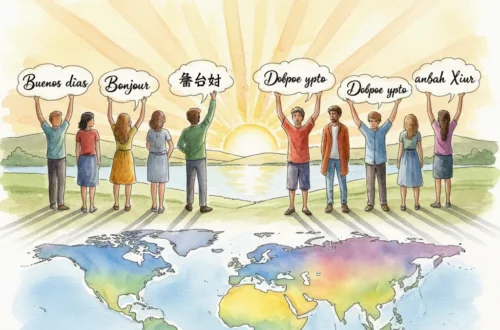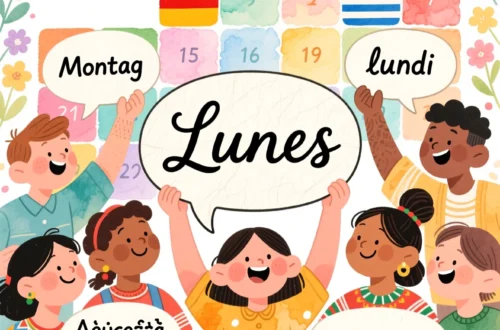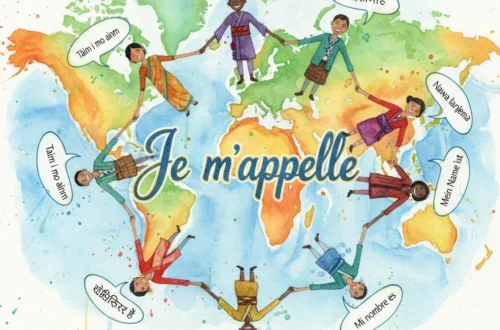The Universal Beat of 10 🌍
In a bustling Mumbai market, a vendor counts “das” mangoes with a grin 🥭. Meanwhile, in a serene Maori village, “tekau” marks a child’s steps in a haka 🪶. Globally, the number “10” symbolizes completeness, from fingers on our hands to milestones in life. For instance, from Tokyo’s math classes to Kenyan communal counts, this number unites us. Moreover, each culture shapes it with unique sounds, reflecting heritage. Thus, let’s journey through the world to explore how “10” resonates! 🚶♂️
Reference Table: “10” Across Languages 📊
To clarify how “10” is expressed globally, the table below lists the word in 15 languages with cultural insights.
| Language | Word for “10” | Cultural/Linguistic Insight |
|---|---|---|
| French | Dix | Used in France’s decimal systems, from markets to math 🇫🇷. |
| Spanish | Diez | Common in Spain’s vibrant counts, like flamenco beats 🇪🇸. |
| German | Zehn | Precise, used in Germany’s structured numbering 🇩🇪. |
| Italian | Dieci | Melodic, heard in Italy’s lively markets 🇮🇹. |
| Mandarin | Shí | Symbolic in China, tied to completeness in culture 🇨🇳. |
| Hindi | Das | Spiritual in India, linked to 10 avatars of Vishnu 🇮🇳. |
| Japanese | Jū | Elegant, used in Japan’s counting systems 🇯🇵. |
| Korean | Sip | Clear, common in South Korea’s daily counts 🇰🇷. |
| Arabic | ‘Ashara | Used across 22 countries, tied to Arabic numerals 🇪🇬. |
| Swahili | Kumi | Communal, used in East Africa’s market tallies 🌍. |
| Zulu | Ishumi | Joyful, marks milestones in South Africa 🇿🇦. |
| Yoruba | Mẹ́wàá | Rhythmic, used in Nigeria’s vibrant counts 🇳🇬. |
| Maori | Tekau | Sacred, tied to Maori communal counts in New Zealand 🪶. |
| Hawaiian | ‘Umi | Gentle, used in Hawaii’s cultural tallies 🌺. |
| Cherokee | Sgohi | Spiritual, used in Native American numbering 🦅. |
European Languages: A Decimal Dance 🕺
Firstly, in Europe, “10” pulses with precision. For example, France’s “Dix” counts market goods in Paris 🇫🇷. Similarly, Spain’s “Diez” marks flamenco rhythms in Seville 🇪🇸. Meanwhile, Germany’s “Zehn” is exact, used in Berlin’s math classes 🇩🇪. Additionally, Italy’s “Dieci” sings in Rome’s lively piazzas 🇮🇹. Furthermore, Russia’s “Desyat” tallies in Moscow’s bustling streets 🇷🇺.
Moreover, the word spans Portugal (“Dez”), Netherlands (“Tien”), Sweden (“Tio”), Poland (“Dziesięć”), Greece (“Déka”), Romania (“Zece”), Hungary (“Tíz”), Finland (“Kymmenen”), Norway (“Ti”), Denmark (“Ti”), Belgium (“Tien/Dix”), Austria (“Zehn”), Switzerland (“Zehn/Dix”), Czech Republic (“Deset”), Slovakia (“Desať”), Croatia (“Deset”), Serbia (“Deset”), Ireland (“Deich”), Ukraine (“Desyat”), and Bosnia (“Deset”). Thus, Europe counts in harmony.
Asian Languages: Symbolic Counts 🏮
Next, Asia expresses “10” with cultural depth across 20+ countries. For instance, China’s Mandarin “Shí” symbolizes completeness in Beijing 🇨🇳. Likewise, Hindi’s “Das” in India, Fiji, and Nepal is tied to Vishnu’s 10 avatars 🇮🇳. Meanwhile, Japanese “Jū” in Japan is elegant, used in Tokyo’s counts 🇯🇵. Similarly, Korean “Sip” in South Korea and North Korea is clear in Seoul 🇰🇷.
Furthermore, Arabic’s “‘Ashara” spans Egypt, Saudi Arabia, Morocco, Algeria, Iraq, Syria, Jordan, Lebanon, UAE, Qatar, Kuwait, Oman, Yemen, Bahrain, Libya, Tunisia, Sudan, Palestine, Mauritania, Somalia, Djibouti, and Comoros, linked to numerals in Cairo 🇪🇬. Additionally, Thai (“Sip” in Thailand), Vietnamese (“Mười” in Vietnam), Malay (“Sepuluh” in Malaysia), Tagalog (“Sampu” in Philippines), and Tamil (“Pattu” in Sri Lanka) add vibrancy. Thus, Asia counts with unity.
African Languages: Communal Tallies 🌍
Additionally, Africa’s “10” resonates with community across 20+ countries. For example, Swahili’s “Kumi” in Kenya, Tanzania, Uganda, Rwanda, Burundi, DR Congo, Mozambique, and Malawi tallies market goods in Nairobi 🌴. Similarly, Zulu’s “Ishumi” in South Africa marks milestones in Durban 🇿🇦. Meanwhile, Yoruba’s “Mẹ́wàá” in Nigeria and Benin is rhythmic in Lagos 🇳🇬.
Moreover, Amharic’s “Asir” in Ethiopia counts in Addis Ababa. Likewise, Hausa’s “Goma” in Nigeria and Niger is used in northern markets. Furthermore, Shona (“Gumi” in Zimbabwe), Xhosa (“Ishumi” in South Africa), Tswana (“Lesome” in Botswana), Oromo (“Kudhan” in Ethiopia), Somali (“Toban” in Somalia), Tigrinya (“Asra” in Eritrea), Wolof (“Fukk” in Senegal), Fula (“Sappo” in Guinea), Akan (“Edu” in Ghana), Luganda (“Kumi” in Uganda), Kinyarwanda (“Icumi” in Rwanda), Malagasy (“Folo” in Madagascar), Bemba (“Icumi” in Zambia), Lingala (“Zomi” in DR Congo), Twi (“Edu” in Ghana), Chewa (“Khumi” in Malawi), and Sotho (“Leshome” in Lesotho) reflect unity. Thus, Africa counts together.
Indigenous & Island Languages: Sacred Numbers 🌺
Furthermore, indigenous and island languages express “10” with cultural depth across 20+ regions. For instance, Maori’s “Tekau” in New Zealand is sacred, used in Rotorua’s counts 🪶. Similarly, Hawaiian’s “‘Umi” in Hawaii (USA) is gentle, heard on Oahu 🌴. Meanwhile, Cherokee’s “Sgohi” in United States communities, like Oklahoma, is spiritual 🦅.
Additionally, Samoan’s “Sefulu” in Samoa and American Samoa strengthens communal tallies. Likewise, Guarani’s “Pa” in Paraguay, Quechua’s “Chunka” in Peru, Bolivia, and Ecuador, Inuktitut’s “Qulit” in Canada, Yolngu’s “Gumanydja” in Australia, Tongan’s “Hongofulu” in Tonga, Fijian’s “Tini” in Fiji, Chamorro’s “Månu” in Guam, Tahitian’s “‘Ahuru” in French Polynesia, Marshallese’s “Juo” in Marshall Islands, Palauan’s “Eruich” in Palau, Nauruan’s “Ata” in Nauru, Niuean’s “Hafua” in Niue, Cook Islands Maori’s “Ngauru” in Cook Islands, Yapese’s “M’uw” in Micronesia, Kosraean’s “Luh” in Micronesia, Pohnpeian’s “Ewe” in Micronesia, Chuukese’s “Eow” in Micronesia, and Iban’s “Sepuloh” in Malaysia add heritage. Thus, “10” counts globally.
Cultural Insights: The Timeless Count of 10 🕰️
Initially, “10” reflects humanity’s love for decimals. For example, Latin “Decem” seeded Romance words like “Dix” and “Diez” 📜. Meanwhile, in Chinese, “Shí” symbolizes perfection, used in ancient calendars 🇨🇳. Additionally, Swahili’s “Kumi” ties to Bantu trade systems in East Africa 🌍.
Furthermore, in Arabic, “‘Ashara” birthed modern numerals, shaping global math 🕌. Similarly, Cherokee’s “Sgohi” aligns with oral counting traditions 🦅. Moreover, colonialism spread forms—Spanish “Diez” in the Philippines, Maori “Tekau” retained cultural depth. Today, from Japan’s elegant “Jū” to Nigeria’s rhythmic “Mẹ́wàá,” “10” unites us in counting’s timeless beat.
Sayings About Numbers 🗣️
The table below organizes 12 sayings about “10,” emphasizing completeness and unity.
| Culture/Language | Saying | Meaning | Country |
|---|---|---|---|
| Spanish | Diez es la danza del todo. | Ten is the dance of wholeness, highlighting completeness. | Spain 🇪🇸 |
| Japanese | Jū wa kansei no kane. | Ten is the bell of perfection, reflecting harmony. | Japan 🇯🇵 |
| Yoruba | Mẹ́wàá ni ipilẹ ayọ̀. | Ten is the foundation of joy, tied to milestones. | Nigeria 🇳🇬 |
| Maori | Tekau he tohu o te katoa. | Ten is a sign of all, focusing on unity. | New Zealand 🪶 |
| Arabic | ‘Ashara kalimat al-tamām. | Ten is the word of completion, linked to fullness. | Egypt 🇪🇬 |
| Swahili | Kumi ni daraja la maisha. | Ten is a bridge of life, emphasizing balance. | Kenya 🌍 |
| Hawaiian | ‘Umi ka helu o ke aloha. | Ten is the number of love, tied to aloha. | Hawaii 🌺 |
| Zulu | Ishumi yisihloko sobunye. | Ten is the key to unity, focusing on togetherness. | South Africa 🇿🇦 |
| Cherokee | Sgohi carries the circle of life. | Ten completes life’s cycle, tied to heritage. | USA 🦅 |
| Hindi | Das ekta ka prateek hai. | Ten is a symbol of unity, symbolizing wholeness. | India 🇮🇳 |
| Amharic | Asir yäzämän märet näw. | Ten is the earth’s number, emphasizing grounding. | Ethiopia 🇪🇹 |
| Guarani | Pa ha’e ñande rekoha. | Ten is our way of being, reflecting identity. | Paraguay 🇵🇾 |
FAQs ❓
The table below answers six key questions about “10” for clarity.
| Question | Answer |
|---|---|
| Why is “10” similar in some languages? | Latin “Decem” seeded “Dix” and “Diez”; short sounds like “Jū” are efficient. |
| What’s the oldest use of “10”? | Sumerian “U” (3000 BCE) and Sanskrit “Daśa” (1500 BCE) appear in early texts. |
| How do cultures use “10”? | China’s “Shí” symbolizes perfection 🇨🇳; Nigeria’s “Mẹ́wàá” is rhythmic 🇳🇬; Hawaii’s “‘Umi” is gentle 🌺. |
| How did colonialism spread “10”? | Spanish “Diez” reached the Philippines; Maori “Tekau” preserved cultural counts 🪶. |
| Why is “10” symbolic? | In Hindi, “Das” ties to 10 avatars; in Arabic, “‘Ashara” shaped numerals. |
| How does tone affect “10”? | In Yoruba, “Mẹ́wàá” is lively; in Japanese, “Jū” is calm, reflecting culture. |
Conclusion: The Global Rhythm of 10 🌏
Ultimately, from “Dix” in French markets to “Tekau” in Maori haka, “10” hums with completeness and unity. Indeed, each culture adds its beat—precision in Spain, spirituality in India, community in Swahili—yet all share its universal count. 🔢 For example, picture this with a map of global numbers or audio clips of “10! Now, share your story: How do you say “10” in your language? Perhaps tell us about a moment “10” marked a milestone. Drop it in the comments and let’s celebrate 10’s global rhythm! 💬





